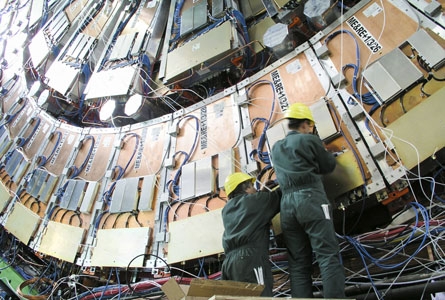The CERN is one of the most prestigious nuclear physics laboratories in the world. It is also the birthplace of the web.
Related article
Founded in 1954, CERN (European Organisation for Nuclear Research) now has 23 member states. Here, physicists from all over the world study the fundamental particles of matter using particle accelerators and detectors. Accelerators bring particles to a high energy to cause collisions, while detectors record the signals left by the particles resulting from the collisions.
Visits
CERN has two permanent exhibitions:
- the "Universe of Particles" exhibition, housed in the Globe ;
- Microcosm , which presents the CERN adventure through a series of interactive experiments.
Guided tours are also available. Advance booking is essential.
CERN's activities
CERN is a fundamental research centre that advances knowledge of the constituents of the Universe and the forces that bind them together.
CERN employs more than 2,500 people and operates a network of eight accelerators and a decelerator that power dozens of experiments. These experiments are conducted by international collaborations of scientists from 900 institutes and universities. Some 17,000 scientists of more than 110 nationalities use CERN's facilities.
The Large Hadron Collider (LHC)
With a circumference of 27 km, the Large Hadron Collider is the largest and most powerful particle accelerator ever built in the world. It circulates particles at close to the speed of light and causes them to collide.
Protons and ions circulate in two tubes surrounded by magnets that guide the particles along their circular trajectory. Most of the magnets in the LHC are superconductors, which means that very high magnetic fields can be achieved. They are cooled to (-271 C°), just two degrees above absolute zero.
The LHC generates collisions at the centre of four large detectors, ALICE, ATLAS, CMS and LHCb. The data collected by the LHC experiments is processed by a global network of computers called the Clacul Grid, which comprises 800,000 processor cores in 170 computing centres around the world.
These experiments seek to answer some of the major questions in contemporary physics, such as:
- What makes up the 96% of the Universe that is not matter as we know it?
- How has matter evolved since the Big Bang, the event at the origin of our Universe?
- What happened to the antimatter that was produced in quantities equal to the matter at the origin of the Universe?
In 2012, two LHC experiments discovered the Higgs particle, whose existence proves a primordial mechanism by which elementary particles acquire their mass.
The cradle of the web
By conducting research at the frontiers of knowledge, CERN develops new technologies that are used in other fields. CERN's best-known invention is the World Wide Web, conceived in 1989 by computer scientist Tim Berners-Lee.
Developed to enable scientists around the world to exchange information, the World Wide Web was launched in 1991. In 1993, CERN placed the project in the public domain. Accessible to everyone and free of charge, the Web quickly saw its use explode on the Internet.
Liens externes
Article modifié le 22.08.2023 à 12:28

